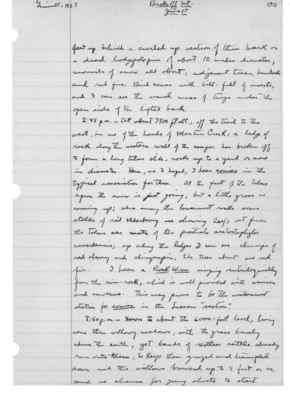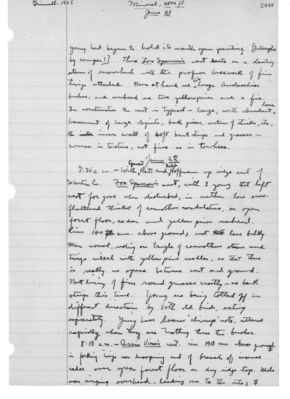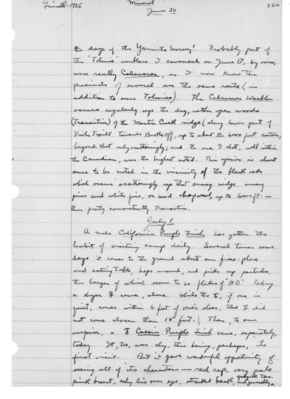Pages That Mention Martin Creek
1925: Joseph Grinnell's field notes
S2 Page 14
Collector: Grinnell - 1925 Location: Lassen Section (Mineral) Date: June 16-17, 1925 Page Number: 2470
without loitering at the threshold. But as it emerges, it looks about a moment, before flying away. Usually when leaving, an adult carries a pellet of excrement in its bill, taking it to a distance, beyond my range of sight. At times both old birds are in the nest hole together. The young must be very small, as I can hear no notes from them when being fed. Such food as I can see brought, consists of green caterpillars. Western Chipping Sparrow's nest: rises 65 inches above ground; in small yellow pine, one of a close growing clump of these out in open away from larger trees, bare ground predominating in vicinity, some clumps of ceanothus (snow-bush). Nest very shallow in outside proportions, resting on needles and two 1/2-inch branches and against main 1&1/2-inch stem of pine. One of the branches forming the support comes from an adjacent tree, but in adjoining against the other so as not to move in ordinary breeze. Bird was sitting closely, and there are four eggs, opaque when held towards the sunlight, so far incubated. June 17 Mollie and I left camp at 6:45 for Berkeley Mountain, via the trail to Viola which leaves the vicinity of Mineral on the gently rising ridge just east of Martin Creek. The trail is a good one tho little traveled, not at all yet this year, save by a horseman up as far as the snow allowed,
S2 Page 18
Collector: Grinnell - 1925 Location: Lassen Section (Brokeoff Mt.) Date: June 17, 1925 Page Number: 2471
feet up behind a curled up section of thin bark on a dead lodgepole pine of about 10 inches diameter; mounds of snow all about; adjacent trees, hemlocks and red firs. Bird comes with bill-full of insects, and I can see the usual mass of twigs under the open side of the lifted park. 2:45 p.m. - At about 7500 ft. alt.; off the trail to the west, in one of the heads of Martin Creek; a ledge of rock along the western wall of the canyon has broken off to form a long talus slide, rocks up to a yard or more in diameter. Here, as I hoped, I hear conies in the typical association for them. At the fast of the Talus apron the snow is just going, but a little grass is coming up; also among the lowermost rocks some stalks of red elderberry are showing leaf; out from the Talus are mats of the prostrate arctostaphylos nevadensis; up along the ledges I can see clumps of red cherry and chinquapin; the trees about are red fir. I hear a Rock Wren singing ventriloquially from the rim-rock, which is well provided with crevices and caverns. This may prove to be the westernmost station for conies in the Lassen "section." 3:50 p.m. - Down to about 600-foot level, having come thru willowy meadows, with the grass barely above the earth, yet bands of restless cattle already run onto them, to keep them grazed and trampled down and the willows browsed up to 5 feet or so, and no chance for young shoots to start.
S2 Page 33
Collector: Grinnell-1925 Location: Mineral, 4800 ft. Date: June 21 Page Number: 2488
young had begun to hold its mouth open pouting. [Interrupted by camper!] This Fox Sparrow's nest rests on a slanting stem of snow-bush with the proper lacework of fine twigs attached. Near at hand are two large Amelanchier bushes; and overhead are two yellow pines and a fir. In construction the nest is typical - large, with abundant loose basement of large objects, bark pieces, section of sticks, etc., the inner wall of soft bark strips and grasses course in texture, not fine as in towhees.
June 22 7:34 a.m. - With ^Egmont Rett and ^Ralph Hoffmann up ridge east of Martin Cr. Fox Sparrow's nest, with 3 young that left nest for good when disturbed, in rather low snow flattened thicket of ceanothus cordulatus, on open forest floor, cedar and yellow pines overhead. Rim 140 ft mm. above ground; nest last less bulky than usual, resting on tangle of ceanothus stems and twigs mixed with yellow pine needles, so that there is really no open space between nest and ground. Nest lining of fine round grasses mostly - no bark strips this time. Young are being lolled (?) off in different direction by both old birds, acting separately. Young have hoarse "chirrup" note, uttered rapidly when they are trotting thru the bushes.
8:15 a.m. - Cassin Vireo's nest: rim 1910 mm. above ground in forking twigs near drooping end of branch of incense cedar over open forest floor on dry ridge top. Male was singing overhead, leading me to the site; [female symbol]
S2 Page 59
Collector: Grinnell - 1925 Location: Mineral Date: June 30 Page Number: 2512
the days of the Yosemite Survey! Probably part of the "Tolmie" warblers I censused on June 17, by voice, were really Calaveras, as I now know the precincts of several over the same route (in addition to some Tolmies). The Calaveras Warbler occurs regular up the dry, rather open woods (Transition) of the Martin Creek ridge (along lower part of Viola Traill towards Brokeoff, up to about the 6000 foot contour; beyond that only scatteringly; and the one I shot, well within the Canadian, was the highest noted. This species is almost sure to be noted in the vicinity of the black oaks which occur scatteringly up that sunny ridge, among pines and white firs, or mid chaparral, up to 6000 ft. thus pretty consistently transitional.
July 1 A male California Purple Finch has gotten the habit of visiting camp daily. Several times some days it comes to the ground about our fire-place and eating table, hops around, and picks up particles, the larger of which seem to be flakes of "H O". Today a shyer [female symbol] came, alone. While the [male symbol], if one is quiet, comes within 6 feet of one's shoes, the [female symbol] did not come closer than 15 feet. \ Then, to our surprise, a [male symbol] Cassin Purple Finch came, separately, today. It, too, was shy, this being, perhaps, its first visit. But it gave wonderful opportunity of seeing all of its characters - red cap, very pale pink breast, ashy line over eye, streaked beak, and generally ^grayish tone.



